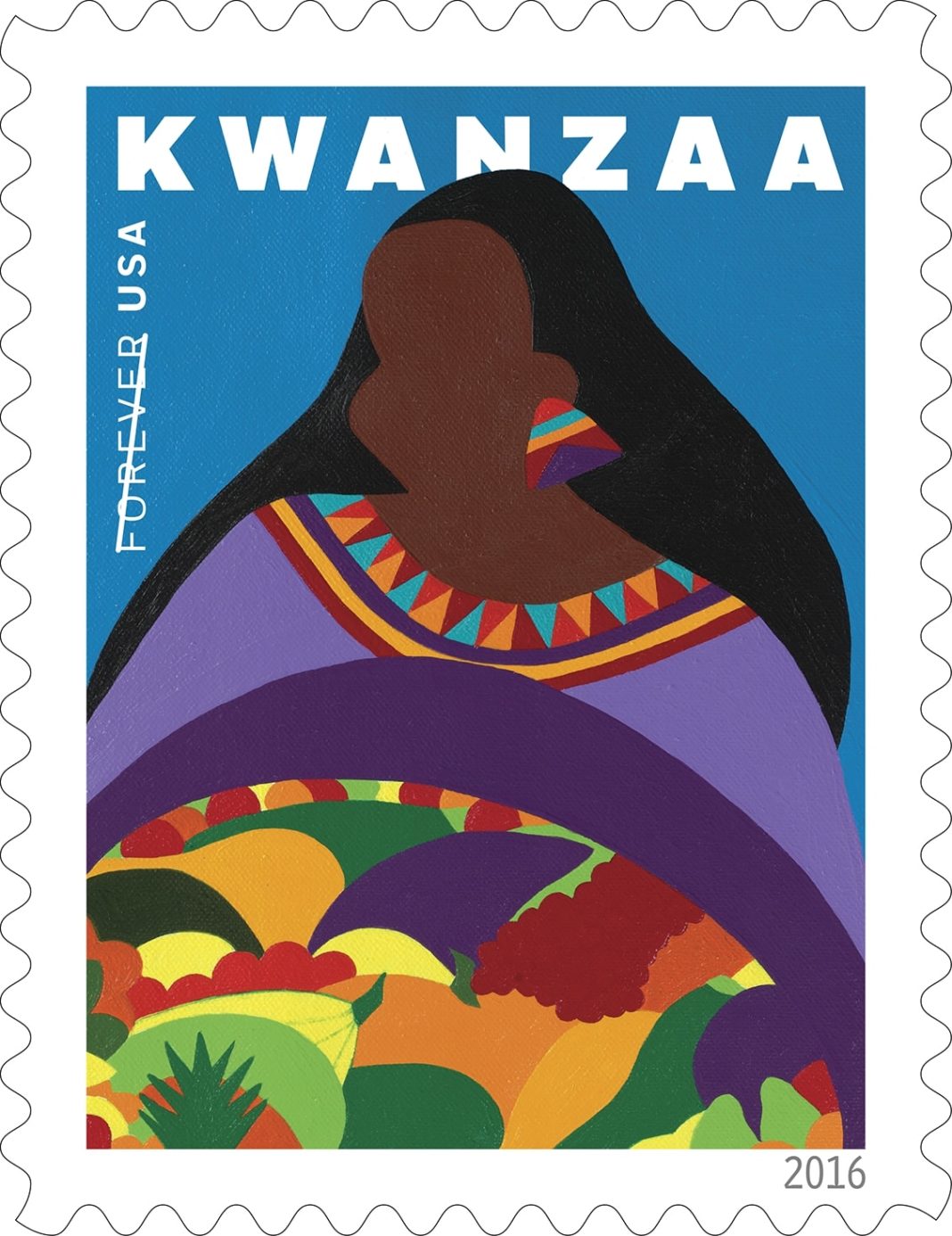
Screenshot via Facebook. Original Photo by Leroy Hamilton
In 1966, pan-African scholar and activist Maulana Ndabezitha Karenga created Kwanzaa as a way to reconnect African-Americans with their West African roots.
The term “Kwanzaa” derives from the Swahili phrase “matunda ya kwanzaa” which translates to “first fruits of the harvest.” From Dec. 26 to Jan. 1, families adhere to seven core principles such as Umoja (unity), Kujichagulia (self-determination), Ujima (collective work and responsibility) and more. They typically create art and music, celebrate Black history, and wear traditional West African clothes like Kente cloth during the week-long holiday.
In honor of the 50th anniversary of Kwanzaa, the United States Postal service released a new stamp on Oct. 1.

The 1997 Stamp
“I was commissioned by the Postal Service to paint the first Kwanzaa stamp in 1996, which was released as a 32-cents stamp on Oct. 22, 1997,” painter Dr. Synthia Saint James told Atlanta Black Star in an exclusive sit-down. “Nearly 19 years later in 2015, I was commissioned again by the USPS. This time to create/paint a Kwanzaa Forever Stamp.”
While the Los Angles-based artist does not celebrate Kwanzaa in the traditional sense, she “actually celebrate[s] the principles of Kwanzaa year-round.” Saint James said the principles of self-determination and creativity are her favorite.

The 2016 Kwanzaa Stamp
Making A Name For Herself
The 67-year-old artist’s work has appeared on the hardcover edition of Terry McMillan’s novel “Waiting to Exhale ” and inside embassies worldwide. In addition, her incredible artwork has been featured in the background of some of your favorite shows from the ’90s, including “The Steve Harvey Show;” “In The House;” “Moesha;” “Martin;” “Hanging With Mr. Cooper;” and “A Different World.”
However, before the fame, Saint James had humble beginnings. In her interview with ABS, she revealed that her career began while in the middle of another one.
In 1969, the then 20-year-old burgeoning artist commissioned her first painting while working as an accounts receivable clerk for a New York mortgage insurance company. That abstract painting for her co-worker launched her 47-year art career.
“I’m a self-taught artist that knew that I wanted to be an artist when I was 5 years old. I wasn’t a child prodigy — just a regular kid who loved to color in my coloring books and to draw.”
That same childlike energy still dominates her work today. Saint James became famous for her use of vibrant colors and complex depictions of Black life across the diaspora.
“But I also enjoy painting the cultures and spirituality of people from all over the world,” she explained. “So I consider myself a multicultural artist.”

Freedom School mural by Synthia Saint James

“The Dream” by Synthia Saint James
Her work draws inspiration from nature, history and other forms of media that she may be enjoying. Furthermore, the artist professed her love for the French Impressionists (Van Gogh and Monet), the artists of the Harlem Renaissance (William Johnson and Archibald Motley), and contemporary artists (Ernie Barnes and Charles Bibbs) who influence her work today.
On Top of the Art World
“My focus wasn’t so much on breaking into the art world,” she recalled. “I initially just wanted to continue to create and sell my paintings to those who would become ‘my collectors.’ Galleries and museums came later, and with my spirit of ‘going for it’ a reputation began to build. So I’ve been blessed.”
That may be an understatement. The exposure and praise her art has received is only one fraction of her many accolades, including an honorary doctorate from Saint Augustine’s University in Raleigh, North Carolina, and an NAACP Image Award Nomination in 2012.
Through her work and with the latest stamp, Saint James ultimately wants to “educate our children and build pride, by celebrating our rich African ancestry.”


